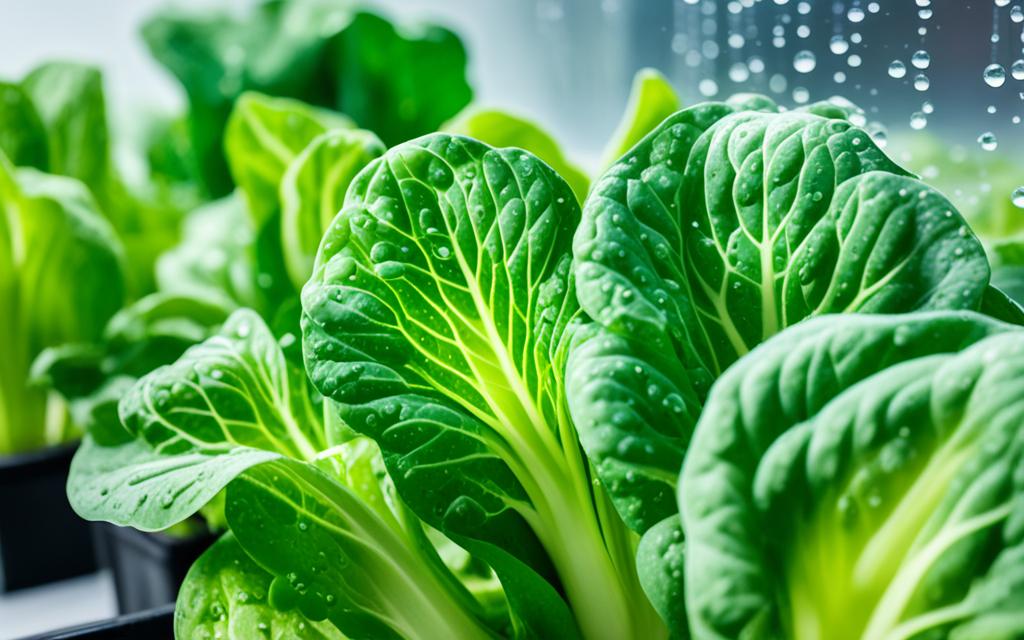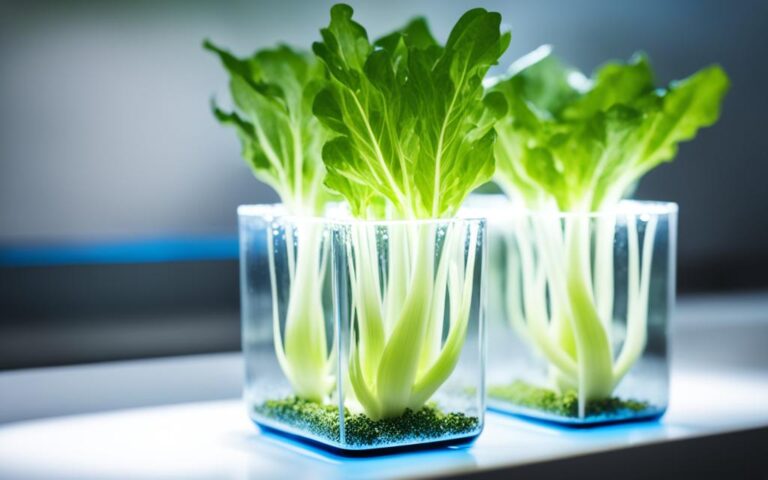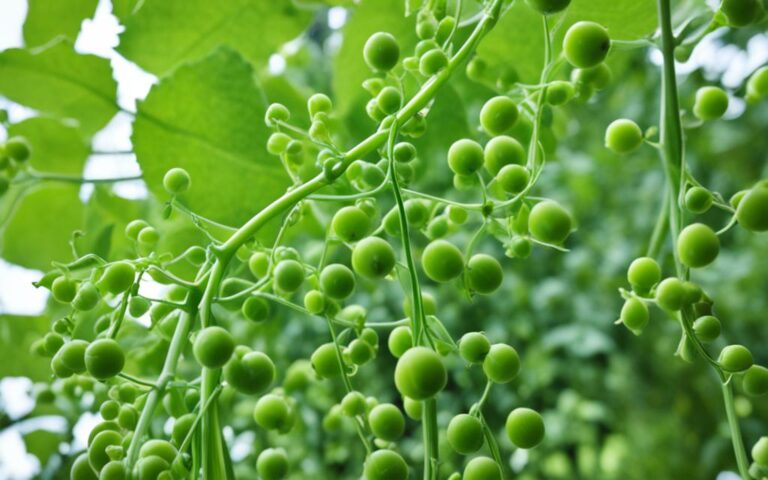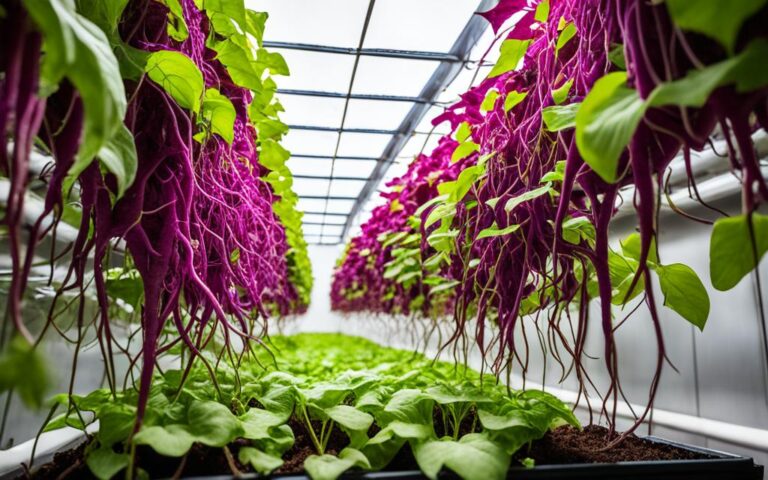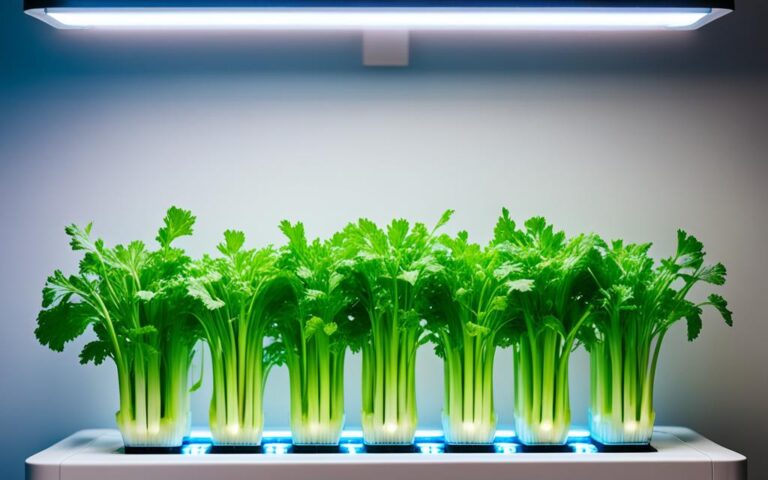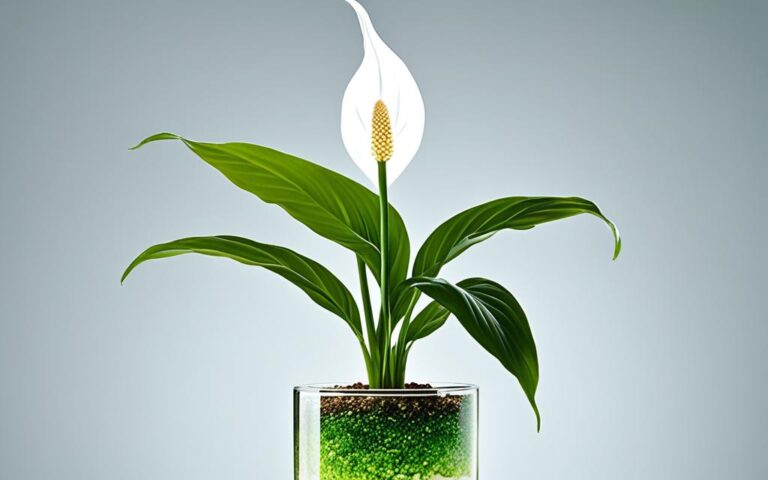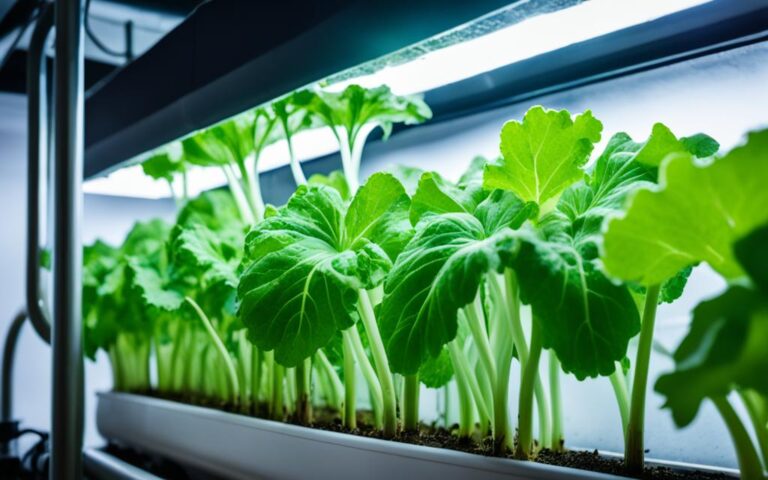Grow Hydroponic Bok Choy with Ease
Explore the world of growing hydroponic Bok Choy. This indoor gardening approach uses no soil, but a nutrient-filled solution. It’s great for city living. In just around 4 weeks, you can pick your own fresh, nutritious Bok Choy. Hydroponics gives Bok Choy everything it needs, making growing simple compared to old-style gardening.
Key Takeaways
- Hydroponic Bok Choy grows without soil, using nutrient solutions for optimal growth.
- Ideal for urban agriculture and indoor gardening setups.
- Harvesting time is typically around 4 weeks from planting seeds.
- Rich in essential vitamins and nutrients, beneficial for a healthy diet.
- Maintaining appropriate pH and EC levels is crucial for successful growth.
Table of Contents
Introduction to Hydroponic Bok Choy
Hydroponic bok choy is a special kind of Chinese cabbage. It’s grown in water instead of soil. This way, plants get nutrients directly, which helps them grow well. Bok choy is perfect for growing this way, making it popular among gardeners and farmers.
What is Hydroponic Bok Choy?
Hydroponic bok choy grows in a controlled setting without soil. It uses different hydroponic systems to feed plants nutrients in water. The plants grow quickly and are healthy, with a big output. They’re also safer from diseases and bugs found in the soil. This method is great for eco-friendly farming.
Benefits of Growing Bok Choy Hydroponically
Growing bok choy hydroponically has many benefits. It lets farmers grow crops all year, no matter the weather. This method saves a lot of water, up to 90% more than in soil farming. Plus, it’s great for cities because it doesn’t need much space. It’s an efficient way to farm, giving us fresh, healthy vegetables and helping the planet.
Choosing the Right Hydroponic System
Choosing the right hydroponic system is key for growing Bok Choy successfully. There are several methods to consider, each with its own benefits. Today, we’ll look at three common choices: Deep Water Culture, Nutrient Film Technique, and Aeroponics. Understanding these can help you select the perfect system for your needs and space.
Deep Water Culture (DWC)
Deep Water Culture (DWC) is a great option for beginners. It works by keeping plant roots in water full of nutrients. This method gives the Bok Choy everything it needs to grow quickly and stay healthy. DWC is easy to manage and doesn’t need much upkeep, making it a solid choice for those starting out.
Nutrient Film Technique (NFT)
The Nutrient Film Technique (NFT) is a bit more complex. It uses a thin stream of nutrients that runs over the roots. This ensures the plants always have water, food, and oxygen. NFT reuses the nutrient mix, so it’s good for saving space and resources. It’s perfect for growing strong, healthy Bok Choy.
Aeroponics
Aeroponics is the high-tech choice among these systems. It sprays the roots with a mist full of nutrients. This gives the roots lots of oxygen, which makes the plants grow faster and healthier. Aeroponics might need more knowledge and setup, but it can produce very high-quality Bok Choy efficiently.
| Hydroponic System | Features | Suitability |
|---|---|---|
| Deep Water Culture (DWC) | Simplicity, continuous submersion in nutrient solution | Beginner-friendly |
| Nutrient Film Technique (NFT) | Thin film of nutrient solution, constant flow | Space and resource efficient |
| Aeroponics | Mists roots, high oxygenation | Advanced growers |
Best Hydroponic Varieties of Bok Choy
Starting your hydroponic journey? Choosing the right bok choy varieties is key. Each kind offers unique growth rates and flavors. This makes selecting the perfect one for your needs crucial.
Baby bok choy is a top pick. It grows about half the size of its traditional counterpart. This makes it perfect for home hydroponic systems. Its small size allows it to flourish in limited spaces. You get a strong yield without it taking over.
Gaea’s Blessing Seeds is another great choice. They provide some of the best hydroponic bok choy seeds out there. With high germination rates and strong growth, these seeds lead to successful crops. And they taste wonderful too.
Check out this comparison table for more details on these hydroponic bok choy varieties:
| Variety | Size | Growth Rate | Flavor Profile |
|---|---|---|---|
| Baby Bok Choy | Compact | Fast | Mild, Sweet |
| Gaea’s Blessing Seeds Bok Choy | Medium | Moderate | Robust, Slightly Peppery |
Choosing the right seeds is critical for a thriving hydroponic garden. Go for reliable, high-quality seeds like baby bok choy and Gaea’s Blessing. You’re sure to enjoy a plentiful, tasty harvest.
Preparing for Planting
Starting your hydroponic garden gives you two choices: begin with bok choy seeds or use transplants. Your decision should match your resources and how you like to grow.
Starting from Seeds
Starting with seeds is one way to kick off your hydroponic pak choi. Seeds need 3-5 days to sprout. You might plant them right in your system or use a Seedling Starter Kit. This kit makes sure they grow well. Checking on them often is key to avoid problems and ensure healthy growth.
Using Transplants
Using transplants is another strategy. Wait until your seedlings show 2-3 real leaves. It means they’re ready for the hydroponic system.
Getting the light and temperature right are big deals for success. With attention and care, your bok choy will flourish and you’ll get lots of it.
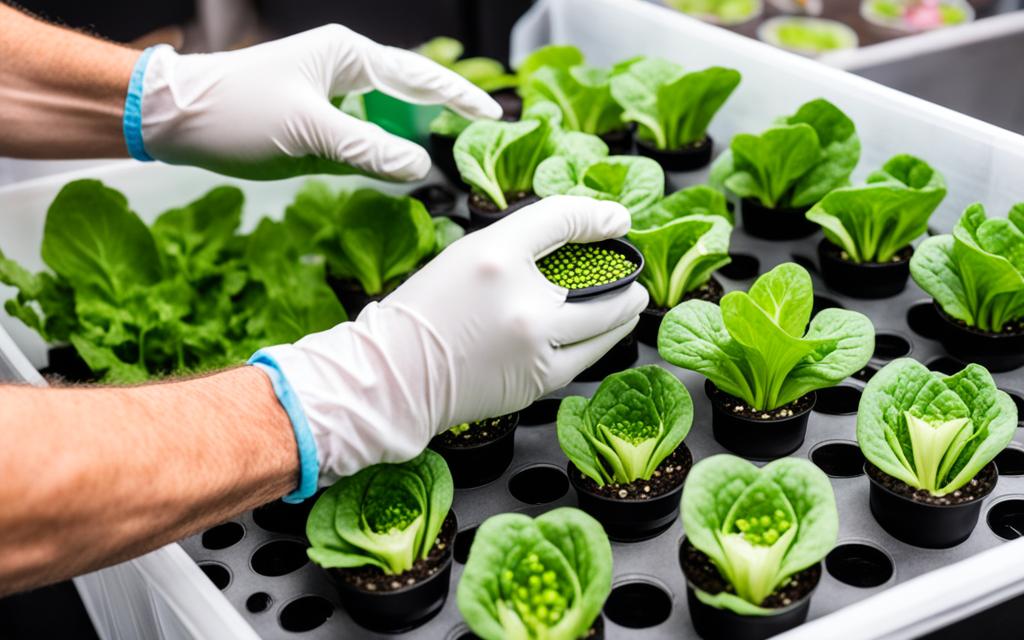
Nutrient Management for Hydroponic Bok Choy
Getting the nutrients right is key for growing strong hydroponic Bok Choy. It’s important to mix the hydroponic nutrients well. This makes sure plants grow quickly and stay healthy.
Choosing the right hydroponic fertilizer for Bok Choy matters a lot. Pick a nutrient solution made for leafy greens. Then, check the Electrical Conductivity (EC) is between 1.5 and 2.0. This confirms everything is mixed right.
Below is an outline of vital nutrients and their sources for good Bok Choy growth:
| Essential Nutrient | Source | Role in Growth |
|---|---|---|
| Nitrogen (N) | Ammonium Nitrate | Promotes leaf growth |
| Phosphorus (P) | Monopotassium Phosphate | Enhances root development |
| Potassium (K) | Potassium Sulfate | Improves overall plant health |
It’s crucial to keep an eye on the nutrient mix for healthy Bok Choy. Make sure the hydroponic fertilizer levels are just right all through the growing period. This leads to the best results.
Optimal pH, TDS, and EC Levels
The health of your hydroponic bok choy relies on the right pH, TDS, and EC levels. Keeping these values balanced is essential for plant health and a good harvest.
Importance of pH Levels
The right hydroponic bok choy pH is crucial for the best nutrient uptake. Bok choy does best with a pH around 7.0. To avoid problems and enhance growth, you should test and adjust the pH regularly.
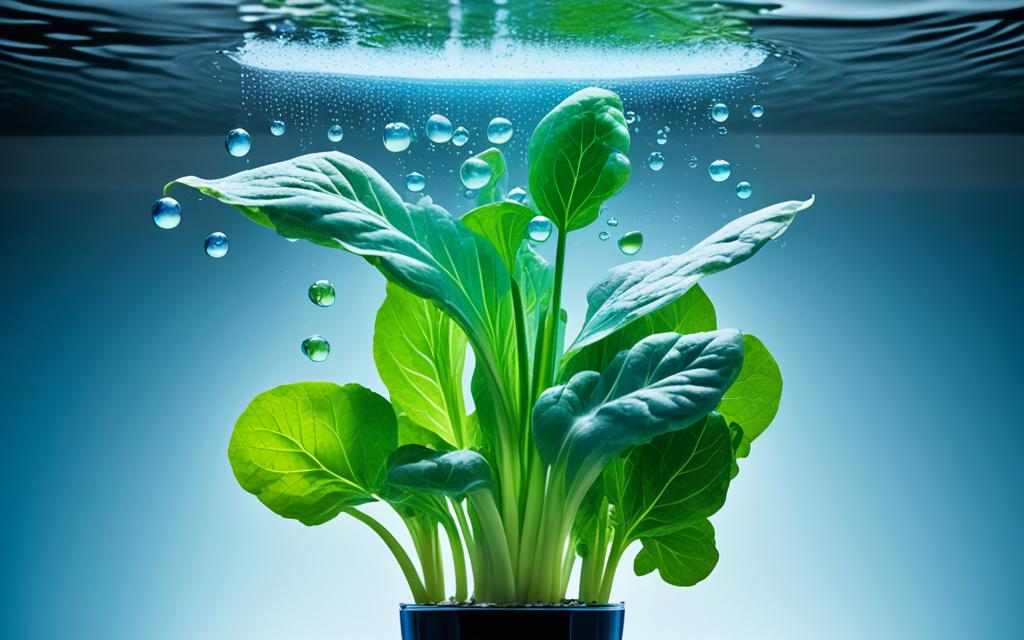
Managing TDS and EC
Correct TDS and EC levels mean your plants get the right nutrient mix. For hydroponic Chinese cabbage, it’s important to find a balance:
| Parameter | Optimal Range |
|---|---|
| pH | 6.0 – 7.0 |
| TDS | 800 – 1200 ppm |
| EC for hydroponic bok choy | 1.2 – 2.0 mS/cm |
You must monitor and tweak these levels often. Doing so prevents issues like nutrient overload or early flowering. This care keeps your hydroponic Chinese cabbage healthy as it grows.
Light and Temperature Requirements
Getting the right amount of light and temperature is key for healthy hydroponic bok choy. It needs a lot of light, about 14-16 hours every day. When there’s not enough sunlight, types of grow lights can help fill in. You can choose from LED, fluorescent, and HID lights. Each has its advantages for different needs.
Keeping the temperature right is just as crucial. Hydroponic bok choy grows best in 50-70 degrees Fahrenheit. Too hot, and the plant might bolt, ruining yield and taste. Too cold, and growth slows down.
Here’s a look at which grow lights work best for hydroponic bok choy towers:
| Type of Grow Light | Advantages | Disadvantages | Suitability for Bok Choy |
|---|---|---|---|
| LED | Energy-efficient, long lifespan | Higher upfront cost | Highly suitable |
| Fluorescent | Low heat output, affordable | Less efficient, shorter lifespan | Moderately suitable |
| HID | High-intensity output | Produces significant heat, may need additional cooling | Suitable with cooling measures |
Choosing the right grow lights and keeping temperatures steady are big steps towards healthy bok choy. These actions help plants grow strong. They also make the veggies taste and feel better.
Common Issues and Troubleshooting
Hydroponic gardening has a lot of benefits. Yet, it still faces some common problems like pests and diseases. To keep your baby bok choy healthy, it’s crucial to check your system often. We will show you how to spot and fix these issues easily.
Identifying Pests and Diseases
Even in hydroponics, pests like cabbage maggots and aphids can appear. It’s good to physically check and remove them early. Sometimes, you might need to use special pesticides. Keeping an eye out for unusual leaf signs can also catch diseases early, so you can act fast.
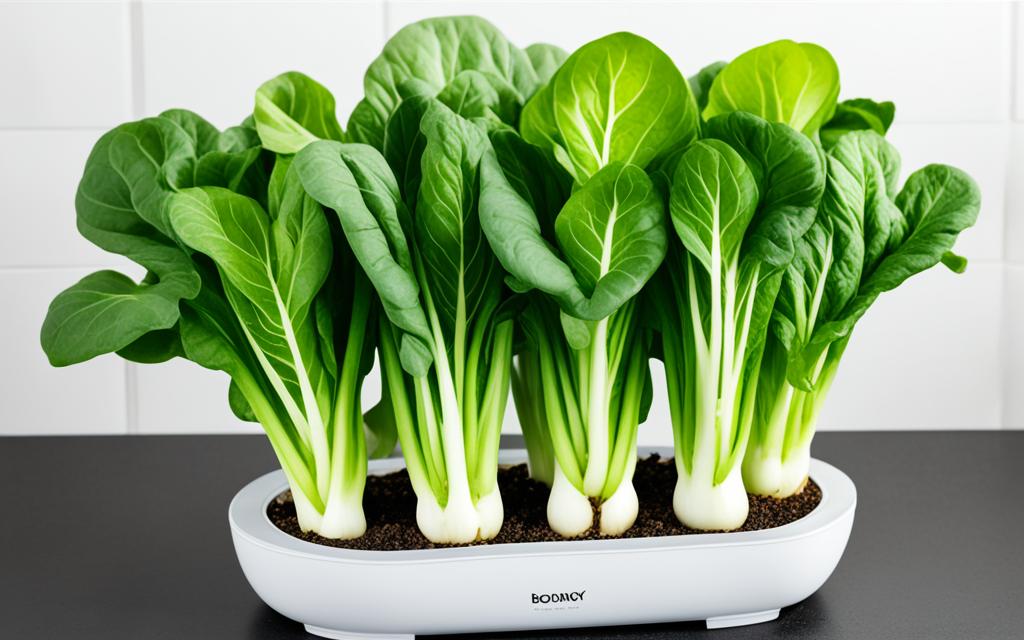
Addressing Nutrient Deficiencies
For great baby bok choy, getting the nutrient mix right is crucial. Regular checks and tweaks of your nutrient solution help. Making sure your plants get the essential big and small nutrients keeps them growing strong and healthy.
Maximizing Your Yield
For a hydroponic bok choy farm to succeed, maximizing yield is key. Using smart pruning and knowing the best time to harvest can greatly improve your crop. Paying close attention during the growing phase leads to a big payoff at harvest time.
Pruning Techniques
Pruning well is vital to get more from your hydroponic bok choy. Getting rid of yellow or damaged leaves helps the plant use its energy better. In the third week, when growth is fast, trim the big outer leaves but let the young ones grow. This method boosts healthy growth and keeps your plants looking good.
Harvesting Tips
Harvesting at the right time is crucial to increase your yield. The best time to harvest hydroponic bok choy is when there are 10-15 healthy leaves. This captures the best taste and nutrients. Regularly picking the outer leaves and leaving the center to grow means you’ll always have something to harvest.
Choosing the best fertilizer for hydroponic bok choy can really increase your yield. The right fertilization, along with good pruning, makes sure your plants get what they need to grow well.
| Factors | Tips |
|---|---|
| Pruning | Remove yellow or damaged leaves, prune outer mature leaves |
| Harvesting | Harvest when plants have 10-15 leaves; frequent outer leaf harvest |
| Fertilization | Use the best fertilizer for hydroponic bok choy |
Hydroponic Bok Choy Nutrient Solution
A balanced nutrient solution is key for growing hydroponic bok choy. It impacts the plant’s growth, especially in vertical farms. Getting the mix right boosts yield and plant health.
The best nutrient solution for bok choy has nitrogen, phosphorus, and potassium. These help the leaves grow and keep the plant healthy. Elements like calcium and magnesium are also needed. They make cells strong and help with chlorophyll.
- Nitrogen is crucial for vegetative growth and lush green leaves.
- Phosphorus aids in energy transfer and root development.
- Potassium enhances water uptake and disease resistance.
Before checking the Electrical Conductivity (EC), mix the nutrients well. This is important for even distribution. It’s very important in vertical farms for a good harvest.
| Macronutrient | Function |
|---|---|
| Nitrogen | Promotes leafy growth |
| Phosphorus | Supports root development |
| Potassium | Enhances water uptake |
| Calcium | Strengthens cell structure |
| Magnesium | Essential for chlorophyll production |
| Iron | Vital for photosynthesis |
| Manganese | Assists enzyme functions |
| Zinc | Facilitates protein synthesis |
Getting the right mix of nutrients and the best growing conditions is crucial. It will help you get a large harvest of healthy, fresh Bok Choy.
Indoor vs Outdoor Hydroponic Bok Choy
Growing hydroponic Bok Choy can work well both inside and outside. Each has its benefits. Indoors, you can control the light, temperature, and humidity. This creates a perfect spot for growing Shanghai Bok Choy hydroponic. A cool indoor method is using a hydroponic Bok Choy tower. It saves space and uses resources wisely.
Outdoor systems get their light from the sun, which can cut down on electricity bills. But, you have to plan carefully to keep your crops safe from bad weather that might stop their growth. Both indoor and outdoor setups need special care to keep your crops healthy all year round.
| Factor | Indoor Hydroponic Bok Choy | Outdoor Hydroponic Bok Choy |
|---|---|---|
| Light Source | Artificial (LED, fluorescent) | Sunlight |
| Temperature Control | Highly controlled environment | Subject to weather changes |
| Cost | Higher initial setup (lighting and climate control) | Lower operational cost (utilizes natural resources) |
| Space Utilization | Efficient with hydroponic bok choy towers | More space required; dependent on natural layout |
| Risk Factors | Power outages, equipment failure | Weather extremes, pest invasion |
Choosing between indoor and outdoor setups depends on what resources you have, the weather, and your goals. Whether you’re using a hydroponic bok choy tower indoors or taking advantage of outdoor resources, both can lead to great Shanghai bok choy harvests.
Vertical Farming for Bok Choy
Vertical farming is changing how we grow veggies, especially in cities where space is scarce. It lets farmers stack crops in layers. This way, they can grow more in the same amount of space.
The hydroponic bok choy tower is a breakthrough in this area. It allows for growing bok choy using less water and growing them faster. These towers also protect the plants from pests and diseases. This boosts both the amount and the quality of what is grown.
Vertical farming lets city farmers produce more food using fewer resources. Below is a table that shows how a hydroponic bok choy tower helps do this better:
| Benefit | Vertical Farming | Traditional Farming |
|---|---|---|
| Space Utilization | Maximized with vertical layers | Limited to horizontal space |
| Water Consumption | Highly efficient | Higher water usage |
| Growth Rate | Faster due to controlled conditions | Slower, dependent on natural factors |
| Pest Control | Minimized risk | Higher susceptibility |
Using hydroponic bok choy towers in vertical farming is a step towards sustainable, efficient city farming. It’s not just about saving space and resources. It’s also about growing healthier plants more efficiently.
Growing Hydroponic Bok Choy Successfully
To grow hydroponic Bok Choy well, you need a good balance. It’s all about daily care and watching closely. Focus on the system and the plant’s health for success.
Daily Care and Maintenance
Every day, check the nutrients, pH, and EC levels. Make sure the lights and temperature are right. Cleanliness is key to prevent algae and diseases.
Monitoring Plant Health
Watching your plants’ health is part of the upkeep. Look for bright green leaves and strong stems. Also, watch out for pests, sickness, or missing nutrients.
Quickly fixing problems keeps your Bok Choy healthy. Stay sharp and act fast for a great garden.
Conclusion
Growing Bok Choy in hydroponic systems is both productive and aligns with eco-friendly farming. By choosing the right systems and nutrients, you can boost your yields. This guide shows you every step, from starting seeds to harvesting, backed with support for your hydroponic journey.
This hydroponic gardening journey requires careful system setup and nutrient balance. It also needs the right light and warmth. These steps help Bok Choy grow well and yield a lot. Hydroponic gardening works in many places, fitting both small urban spaces and big farms.
In short, hydroponic Bok Choy farming is a path to eco-conscious agriculture. With this guide, you have what you need to grow Bok Choy efficiently. This approach helps grow food sustainably, increasing food security and supporting green farming methods.
